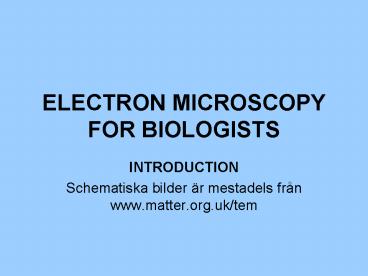ELECTRON MICROSCOPY FOR BIOLOGISTS
1 / 40
Title:
ELECTRON MICROSCOPY FOR BIOLOGISTS
Description:
Microscopy techniques - produce images at greater than life size - Magnification, M ... of structural entities ranging in size from organisms to macromolecules. ... –
Number of Views:92
Avg rating:3.0/5.0
Title: ELECTRON MICROSCOPY FOR BIOLOGISTS
1
ELECTRON MICROSCOPY FOR BIOLOGISTS
- INTRODUCTION
- Schematiska bilder är mestadels från
www.matter.org.uk/tem
2
What is microscopy?
- Microscopy techniques - produce images at greater
than life size - - Magnification, M
- M D/d (size of feature in the image and d the
size of feature in object).
3
The purpose of microscopy is insight, not
images - R.W. Hamming
- Understanding of biological systems is derived
from a knowledge of the spatial and temporal
arrangement of structural entities ranging in
size from organisms to macromolecules.
4
The scale of things
5
Proportions
6
Detection
- light microscopy photons interact with the
specimen - electron microscopy electrons interact with the
specimen TEM and SEM - scanning probe microscopy utilizes a variety of
different interactions of a fine tip with the
specimen. Atomic forces
7
Resolving power line
8
Visualization
- Obtaining an image.
- Record the images for analysis or for
documentation purposes. - Film recording is the only technique available on
older equipment. - Silver based photographic film, expensive,
enables good resolution. - Modern instruments use digital image capture.
- Transferred to a computer screen, stored or
printed - Digital images are readily accessible for
subsequent computer analysis.
9
Analysis
- Counting or measuring of objects in the images.
- May involve considerable computer processing of
the images before the objects can be analysed. - 3-D modelling
10
Physical limitations
- In transmission electron microscopy electrons
pass through thin specimens (50-1000 nm). BULK
BEAM - In scanning electron microscopy signals emitted
from the surface of thick specimens. NARROW BEAM
11
why do we bother with clumsy electron-microscopy?
- The resolution of a microscope smallest
distance between two points in the specimen gt
perceived as separate in the image. - resolution is determined by the wavelength of the
radiation used. - resolving power of a particular system (Rayleigh
criterion) - DR 0.61 l / N.A.
- where DR is the resolution
- l is the wavelength of the radiation used
- Numerical Aperture sin of half the angle of
the cone of radiation entering the lens - Resolution gain by a shorter wavelength or
collect more data from your specimen by having
a larger numerical aperture.
12
- RADIO WAVES MICROWAVES INFRARED VISIBLE
ULTRAVIOL. X-RAYS g -rays
- visible wavelength 390nm 750nm.
- Many cellular structures are much smaller than
this. - It is impossible to make lenses with a NA gt 1.4
- limit of resolution due to aberrations is 170nm.
- high absorbance for shorter wavelength radiation
- UV lenses of quartz or fluorite are expensive
13
electrons accelerated by 60 KVl 0,003 nm
14
TEM column
15
The way forward is to use electrons
- Short wavelength given by the de Broglie
wavelength equation - E hc/l
- E the kinetic energy of the particle,h
Plancks constant, c velocity of light in a
vacuum l the wavelenth of the particle. - e- beams can readily be generated, using an
electron gun. - because of their charge they can be focused by
electromagnetic lenses. - Electrons can be generated The kinetic energy
they acquire is given by E Vq - V the accelerating voltage q the charge on
the electron
16
elektronkanon
17
Elektronmikroskopi på web
- http//www.matter.org.uk/tem/
- http//nobelprize.org/physics/educational/microsc
opes/tem/index.html
18
Transmission electron microscopes comparable to
light microscopes
- Electron beam path
- electron gun generates a beam
- condensor controls illumination
- objective lens magnifies image of the object
- Projector lenses, like an eyepiece, magnifies
further
19
Constraints on the use of electrons
- Vacuum is essential Moderate energy (60-200keV)
electrons have a path length of a few mm in air - Electron optical systems require a path 1 meter
- The sample cant be volatile or wet
- The absorbance of a material for electrons
depends on its density. - The practical thickness limit is lt 500nm for
200kV electrons. - Electrons are charged and interact strongly with
matter ionize. - If electrons accumulate in the specimen it will
repel the electrons in the beam. (worst in SEM) - electrons falling on the specimen must be
conducted to earth. C or Au sputtering - Electron beam has considerable kinetic energy, ?
specimen temperature. Potentially resulting in
damages.
20
Lens effect
- A strong magnetic field is generated by passing
a current through a set of windings. - This field acts as a convex lens, bringing off
axis rays back to focus. - Focal length can be altered by changing the
strength of the current. - The image is rotated, to a degree that depends
on the strength of the lens.
21
Magnification
22
Lens magnification
23
Double condenser system
24
1st condenser
25
2nd condenser
26
Condenser aperture
27
Objective aperture
28
Dark field and diffraction
29
Intermediate lens
30
Illumination adjustments
31
Total magnification
32
Depth of field
33
Smaller aperture
34
Beam alignment
35
Beam alignment
36
Stigmators
37
Interaction with the specimen
38
Electrons interact
39
The preparation of the material
- key importance that the preparation of the
material be properly controlled. - should be applied with understanding.
40
Specimen preparation































